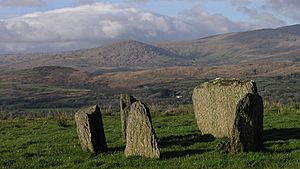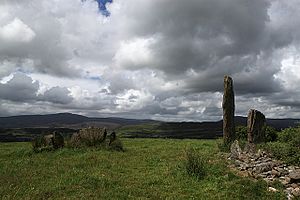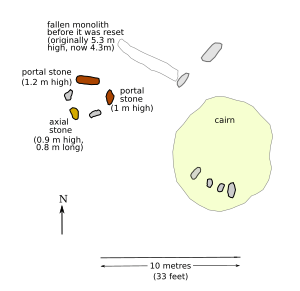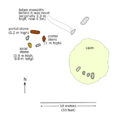Kealkill stone circle facts for kids
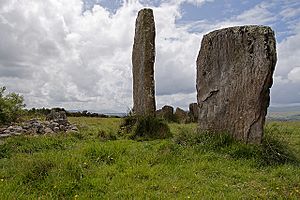
The Kealkill stone circle is an ancient monument from the Bronze Age. It is a special type of stone circle with five main stones. You can find it just outside the village of Kealkill in County Cork, southwest Ireland. When experts dug up the site in 1938, they thought a key stone, called the 'axial stone', pointed north. This was unusual, as most similar circles point southwest. However, later archaeologists believe a smaller stone to the southwest is actually the axial stone. There are also two tall standing stones nearby. One of these had fallen over but was put back up in 1938.
Contents
What Kind of Stone Circle Is It?
Kealkill is a great example of stone circles found in counties Cork and Kerry. In 1909, these circles were first called "recumbent stone circles." This was because they looked a bit like circles in Scotland, which also had a stone lying flat.
However, in 1975, an archaeologist named Seán Ó Nualláin noticed big differences. He decided to call the Irish circles "Cork–Kerry stone circles." The most important stone in these circles became known as the "axial stone." This stone points southwest from the center of the circle. Ó Nualláin found two types of Cork–Kerry circles. Kealkill belongs to the group with five stones.
Where Is Kealkill Stone Circle Located?
This famous stone circle sits on the side of Maughanclea Hill. It is about 400 to 500 feet high. From here, you can see beautiful Bantry Bay. The land around it would have been good for farming long ago. You can even see the Breeny More Stone Circle far away to the southwest.
The stones in the circle are shaped a bit like an oval. They measure about 2.8 meters by 2.4 meters. There are also two tall standing stones and a small stone mound, called a ring cairn, nearby. In 1938, after digging, people thought the large stone on the north side was the axial stone. But in 1984, Ó Nualláin suggested the small slab, only 0.76 meters high, on the southwest side was the real axial stone. The two "portal stones" are on the opposite side from the axial stone. They are both about 1.2 meters tall but have different widths. One is 1.2 meters wide, and the other is 0.5 meters wide.
About 5 meters to the northeast, you'll find the two tall standing stones, also known as menhirs. They are 1.6 meters apart. The shorter, wider one is 2.3 meters tall. The taller one was originally 5.3 meters high. However, by the time of the 1938 dig, this stone had fallen. It was probably blown down in a strong wind. Only a 5-meter broken piece and a small stump (about 12 inches) were left. The archaeologists put the broken piece back up, making it 4.3 meters tall today. Two meters southeast of these standing stones is the cairn. It has four stones around its edge.
What Did Archaeology Discover?
In 1938, archaeologists found two shallow ditches crossing near the center of the stone circle. These ditches were in the peaty ground. They thought these ditches might have once held wooden beams. These beams could have supported a vertical wooden post. If this is true, it would be a very unique feature for this type of stone circle.
When they dug up the cairn, they found it originally had 18 stones around its edge. These stones were arranged like spokes on a wheel. The original ring of stones was a bit smaller than the cairn's 7.6-meter diameter. Sadly, nothing was found that could help them figure out the exact age of the site. There were also no signs of burials inside the circle or the cairn.
Images for kids


